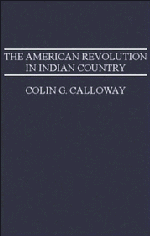Book contents
- Frontmatter
- Dedication
- Contents
- List of figures and maps
- Preface
- Acknowledgments
- Abbreviations
- Prologue New worlds for all: Indian America by 1775
- 1 Corn wars and civil wars: the American Revolution comes to Indian country
- 2 Odanak: Abenaki ambiguity in the North
- 3 Stockbridge: the New England patriots
- 4 Oquaga: dissension and destruction on the Susquehanna
- 5 Fort Niagara: the politics of hunger in a refugee community
- 6 Maquachake: the perils of neutrality in the Ohio country
- 7 Chota: Cherokee beloved town in a world at war
- 8 Tchoukafala: the continuing Chickasaw struggle for independence
- 9 Cuscowilla: Seminole loyalism and Seminole genesis
- 10 The peace that brought no peace
- Epilogue A world without Indians?
- Index
10 - The peace that brought no peace
Published online by Cambridge University Press: 18 December 2014
- Frontmatter
- Dedication
- Contents
- List of figures and maps
- Preface
- Acknowledgments
- Abbreviations
- Prologue New worlds for all: Indian America by 1775
- 1 Corn wars and civil wars: the American Revolution comes to Indian country
- 2 Odanak: Abenaki ambiguity in the North
- 3 Stockbridge: the New England patriots
- 4 Oquaga: dissension and destruction on the Susquehanna
- 5 Fort Niagara: the politics of hunger in a refugee community
- 6 Maquachake: the perils of neutrality in the Ohio country
- 7 Chota: Cherokee beloved town in a world at war
- 8 Tchoukafala: the continuing Chickasaw struggle for independence
- 9 Cuscowilla: Seminole loyalism and Seminole genesis
- 10 The peace that brought no peace
- Epilogue A world without Indians?
- Index
Summary
For all the devastation the American Revolution brought to Indian country, Indians remained a force to be reckoned with at the war's end. In reading the reports of American invasions of Indian country, it is easy to assume, as did some American commanders, that burning Indian villages and destroying crops constituted a knockout blow. But burning homes, razing fields, and killing noncombatants does not necessarily destroy people's will to fight or even their ability to win. Geoffrey Parker's observation about the resilience of peasant communities victimized by European wars – “as in Vietnam, what was easily burnt could also be easily rebuilt” – sometimes held true for Indian communities during the Revolution. Many survived the destruction of their villages. George Rogers Clark recognized the limitations of the American search-and-destroy missions, and an officer on Sullivan's campaign agreed that burning crops and villages was not the same as killing Indians: “The nests are destroyed but the birds are still on the wing.” A British officer reviewing the American campaigns against the Iroquois and the Cherokees agreed that such a system of warfare was “shocking to humanity,” and as sound military strategy was “at best but problematical.” The Indians in the West were holding their own in 1782. The real disaster of the American Revolution for Indian peoples lay in its outcome.
Speaking on a war belt in council with the British in Detroit in December 1781, the Delaware war chief Buckongahelas declared that his warriors had been making blood “fly” on the American frontier for five years. The next year, 1782 the last of the war, witnessed even bloodier conflict. Indians routed American forces at Blue Licks and Sandusky. Americans slaughtered Moravian Delawares at Gnadenhütten and burned Shawnee villages. Delawares ritually tortured Colonel William Crawford and, as atrocities mounted, they and the Shawnees pushed “their retaliation to great length by putting all their prisoners to death.” Then the British and Americans made peace.
- Type
- Chapter
- Information
- The American Revolution in Indian CountryCrisis and Diversity in Native American Communities, pp. 272 - 291Publisher: Cambridge University PressPrint publication year: 1995



